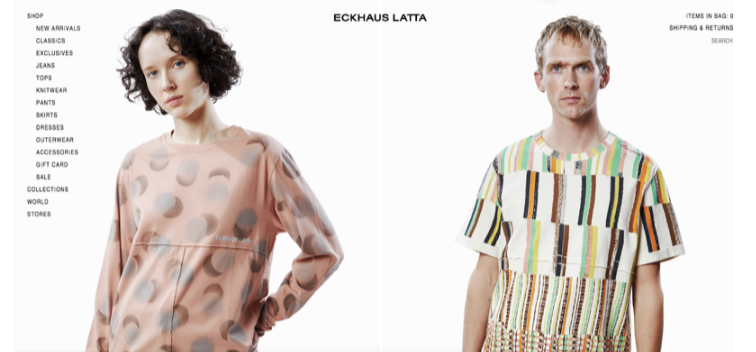 Eckhaus Latta has released their Spring 2021 Ready-to-Wear collection, including 23 looks shown interchangeably on models varying identities, showing that clothing is not meant for one person or the other, and that beautiful fashion can be achieved without those limitations.
Typically for designer brands, seasonal collections are released in categories of men and women. That is, until Eckhaus Latta came along and revolutionized how people shop online, removing the barriers, troubles, and limitations people often encounter when trying to find clothes that match how they want to present- not just masculine or feminine, but a balance of both, known as androgyny.
This collection on Eckhaus Lattas website, rather than categorizing by gender, is categorized by clothing articles. For example, instead of navigating the mens and womens sections of the website, navigation is divided by pieces such as Tops, Jeans, Skirts, etc. Each article is shown modeled more than once, on various looks of person.
Eckhaus Latta has released their Spring 2021 Ready-to-Wear collection, including 23 looks shown interchangeably on models varying identities, showing that clothing is not meant for one person or the other, and that beautiful fashion can be achieved without those limitations.
Typically for designer brands, seasonal collections are released in categories of men and women. That is, until Eckhaus Latta came along and revolutionized how people shop online, removing the barriers, troubles, and limitations people often encounter when trying to find clothes that match how they want to present- not just masculine or feminine, but a balance of both, known as androgyny.
This collection on Eckhaus Lattas website, rather than categorizing by gender, is categorized by clothing articles. For example, instead of navigating the mens and womens sections of the website, navigation is divided by pieces such as Tops, Jeans, Skirts, etc. Each article is shown modeled more than once, on various looks of person.
When shopping on the website, the pieces first appear shown on one model. Upon moving the mouse over the image of the model, another model with a different identity is shown wearing that same article. This further exemplifies the intended fluidity of the clothing and that they can be utilized by different people with different looks.
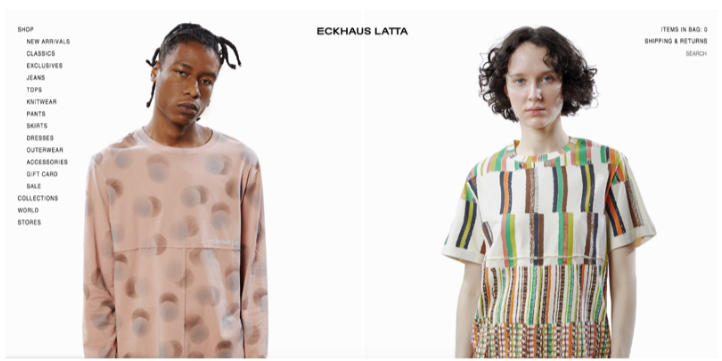

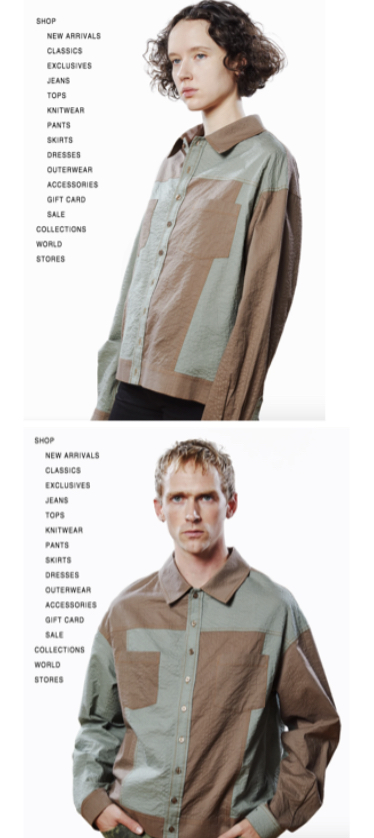 Eckhaus Lattas practices enable customers to imagine themselves in any and all pieces from the collection on the website, helping to connect the customers to the mission of the brand. This website layout is very refreshing for a new generation of online shoppers, especially in a pandemic climate.
High fashion should be accessible to all, but notoriously has not always been. For individuals who also seek to escape the formality guidelines of fashion, something as simple as structuring a website this way is revolutionary.
The look of the models, however, help to emphasize the versatility of the collection by displaying their androgyny. The pieces bring out the feminine and the masculine in whoever wears them, so why designate who they are meant for?
Eckhaus Lattas practices enable customers to imagine themselves in any and all pieces from the collection on the website, helping to connect the customers to the mission of the brand. This website layout is very refreshing for a new generation of online shoppers, especially in a pandemic climate.
High fashion should be accessible to all, but notoriously has not always been. For individuals who also seek to escape the formality guidelines of fashion, something as simple as structuring a website this way is revolutionary.
The look of the models, however, help to emphasize the versatility of the collection by displaying their androgyny. The pieces bring out the feminine and the masculine in whoever wears them, so why designate who they are meant for?
As seen above, the models strutting in the new Eckhaus Latta Spring 2021 Collection promote the androgynous, boundaryless nature of the garments. Each model is presented with a balance of masculine and femine presentation that allows the collection’s unique design edge to emerge. Masculinity enhanced by femininity and vice versa creates and accentuates the already stunning pieces in this collection, and helps customers to envision themselves in the clothes but also gives them the freedom to express their androgyny like those models.
It makes sense that Eckhaus Latta is one of most up and coming designers in high fashion at the moment due to their willingness to take steps like updating their website for a modern audience and letting the public see more of themselves in the models on the runway. The diversity, whether it be in race, gender, presentation or body shape, is present in Eckhaus Lattas 2021 Spring collection. Eckhaus Latta has become known for incorporating various identities with an emphasis on androgyny within their runway models in the past, but this season sets a great example of organic inclusion for other high fashion brands to catch on to.
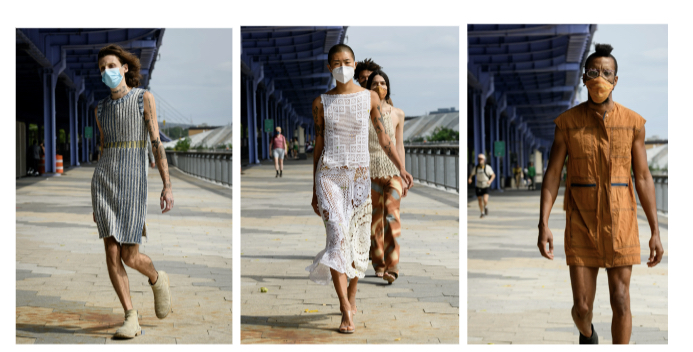
Written By: Erica Stanley

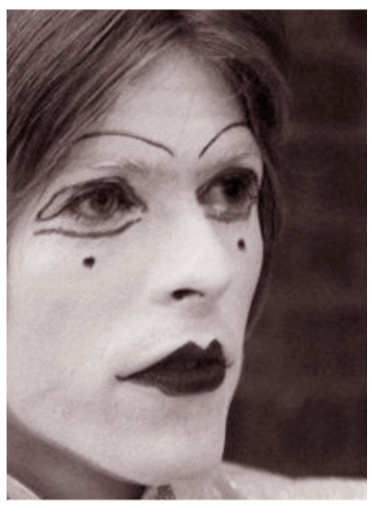 Before Harry Styles was touted as the great purveyor of androgynous fashion, another independent, male musician paved the way. David Bowie, often regarded as one of the most influential artists of the 20th century, constantly pushed the boundaries of both music and fashion. His innovation in these spaces, specifically fashion, shifted public perceptions of gender in fashion and art. He used clothing as a way of
Before Harry Styles was touted as the great purveyor of androgynous fashion, another independent, male musician paved the way. David Bowie, often regarded as one of the most influential artists of the 20th century, constantly pushed the boundaries of both music and fashion. His innovation in these spaces, specifically fashion, shifted public perceptions of gender in fashion and art. He used clothing as a way of 
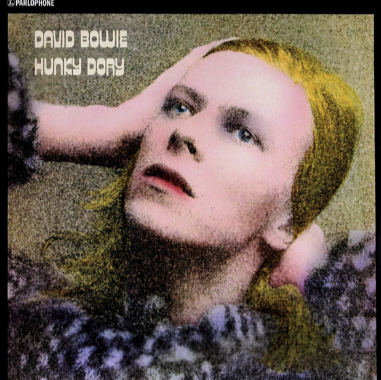 Bowie, extremely creative and imaginative, continued his self-expression through fashion with the invention of his alter-ego, Ziggy Stardust. He came up with the concept after collaborating with Japanese designer Kansai Yamamoto, revealing how important fashion was on his musical and personal identity. Ziggy Stardust, a genderless, unearthly figure, was first debuted by Bowie in 1972. Often dressed in outfits that were neither wholly masculine or feminine, Ziggys identity transcended the restrictive gender boundaries of fashion at the time.
David Bowie’s specific androgynous fashion choices throughout his career redefined the triangular relationship between gender, fashion and music. Bowie inspired people of all backgrounds and identities to become comfortable with gender bending and not presenting oneself as either male or female. His androgynous fashion choices allowed fans who werent previously represented in either the fashion or music industry to feel represented by him and encouraged to express themselves and their gender identities through their clothing. Bowies influence on androgyny and fashion is one that has completely merged both industries, and paved the way for others to dress as they feel best expresses themselves.
Bowie, extremely creative and imaginative, continued his self-expression through fashion with the invention of his alter-ego, Ziggy Stardust. He came up with the concept after collaborating with Japanese designer Kansai Yamamoto, revealing how important fashion was on his musical and personal identity. Ziggy Stardust, a genderless, unearthly figure, was first debuted by Bowie in 1972. Often dressed in outfits that were neither wholly masculine or feminine, Ziggys identity transcended the restrictive gender boundaries of fashion at the time.
David Bowie’s specific androgynous fashion choices throughout his career redefined the triangular relationship between gender, fashion and music. Bowie inspired people of all backgrounds and identities to become comfortable with gender bending and not presenting oneself as either male or female. His androgynous fashion choices allowed fans who werent previously represented in either the fashion or music industry to feel represented by him and encouraged to express themselves and their gender identities through their clothing. Bowies influence on androgyny and fashion is one that has completely merged both industries, and paved the way for others to dress as they feel best expresses themselves.
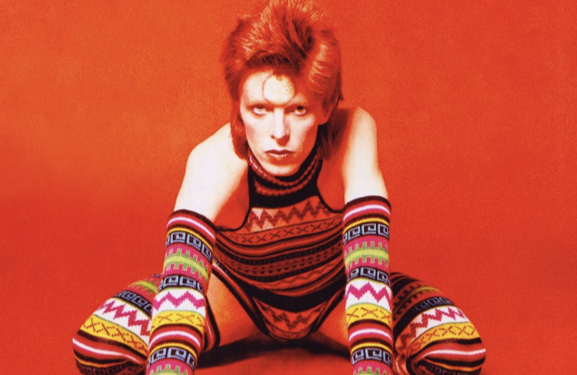 Written By: Wynne Dieffenbach
Written By: Wynne Dieffenbach